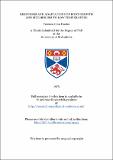Files in this item
Responses and adaptations of root growth and metabolism to low temperature
Item metadata
| dc.contributor.advisor | Crawford, R. M. M. | |
| dc.contributor.author | Huxter, Terence John | |
| dc.coverage.spatial | 168 p. | en_US |
| dc.date.accessioned | 2018-06-20T14:42:01Z | |
| dc.date.available | 2018-06-20T14:42:01Z | |
| dc.date.issued | 1975 | |
| dc.identifier.uri | https://hdl.handle.net/10023/14355 | |
| dc.description.abstract | A comparative study of the carbohydrate metabolism of roots of pea (Pisum sativum var. meteor) and maize (Zea mays var kelvedon glory) seedlings was undertaken at low temperatures (2-14°C) with the aim of demonstrating differences between these species which may be associated with the differing growth capacities of their roots mot this temperature range. Pea roots displayed linear growth rates at all temperatures tested whereas maize roots ceased growth over five days at temperatures below 6°C At the respective temperatures which were minimal for root growth of the two species, roots behaved similarly with regards to soluble sugar content; firstly, total content was maintained in the roots at the initial level, and secondly, sucrose content was at its highest value and glucose content at its lowest. With rise in temperature sucrose content declined while glucose content increased. In maize roots kept at those temperatures where growth was not sustained this relationship broke down. Total sugar content of the roots was not maintained, glucose content was abnormally high and sucrose content very low. Similarly, respiration rate of maize roots at 2°C was abnormally low. When seedings were grown with roots bathed in an external solution of glucose at 2°C (or of glucose or of sucrose at 6°C the disturbances to sugar metabolism and respiration rate of maize roots were partially alleviated and this was associated with a greater amount of growth made by the roots. Examination of the activity and Km of acid invertase extracted from the roots and partially purified, showed that the sucrose levels in roots of both species were inversely related to invertase activity. However in pea, but not in maize roots, Km values for invertase showed a lowering in value after growth of seedlings at 2°C compared with 20°C. Furthermore, in pea, after growth of seedlings at 14 or 2°C Km determined at 2°C was significantly lower than when determined at 14°C. These properties are of adaptive significance at low temperatures since they will act to maintain an appreciable reaction rate. Shifts in Km of a homeostatic nature with respect to temperature were not recorded for invertase from maize roots and in this species the failure to control invertase activity at low temperatures with consequent depletion of sucrose may be associated with the inability of this species to show sustained growth at 2°C. Examination of the Km of MDH likewise revealed a shift in Km value tending to buffer the effect of temperature on reaction rate for MDH from pea but not from maize roots. | en_US |
| dc.language.iso | en | en_US |
| dc.publisher | University of St Andrews | |
| dc.subject.lcc | QK756.H8 | en |
| dc.subject.lcsh | Plants—Effect of cold on | en |
| dc.title | Responses and adaptations of root growth and metabolism to low temperature | en_US |
| dc.type | Thesis | en_US |
| dc.contributor.sponsor | University of St Andrews. Research Scholarship | en_US |
| dc.type.qualificationlevel | Doctoral | en_US |
| dc.type.qualificationname | PhD Doctor of Philosophy | en_US |
| dc.publisher.institution | The University of St Andrews | en_US |
This item appears in the following Collection(s)
Items in the St Andrews Research Repository are protected by copyright, with all rights reserved, unless otherwise indicated.

